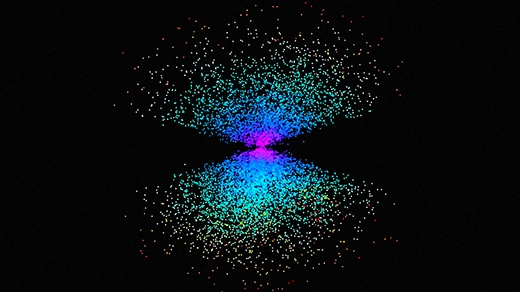The eRosita team, however, found no such discrepancy. “Our result was basically in line with the prediction from the very early time, from the CMB,” said Vittorio Ghirardini, who led the analysis. He and his colleagues calculated an S8 of 0.85.
Some team members were disappointed, Ghirardini said, since hinting at missing ingredients was a more exciting prospect than matching the known theory.
The S8 value sitting a tad higher than the CMB estimate will likely trigger more analysis from other teams, said Gerrit Schellenberger, an astrophysicist who studies galaxy clusters at the Harvard-Smithsonian Center for Astrophysics. “I believe it’s probably not the last paper we have seen on that topic.”
Weighing Neutrinos
Copious neutrinos formed in the early universe — nearly as many as photons (particles of light), said Marilena Loverde, a cosmologist at the University of Washington. But physicists know that neutrinos, unlike photons, must have tiny masses because of how they oscillate between three types. The particles don’t acquire mass through the same mechanism as other elementary particles, so their mass is a much-studied mystery. And the first question is how massive they actually are.
Cosmologists can estimate the mass of neutrinos by studying their effects on the structure of the cosmos. Neutrinos zip around at nearly the speed of light and pass right through other matter rather than glomming onto it. So their presence in the cosmos has attenuated its clumpiness. “The more mass you put on neutrinos, the more of the mass that is smooth on those [large] scales,” Loverde said.
Combining their galaxy cluster measurements with CMB measurements, the eRosita team estimated that the sum of the masses of the three types of neutrinos is no more than 0.11 electron volts (eV), or less than a millionth of the mass of an electron. Other neutrino experiments have established a lower bound, showing that the three neutrino masses must add up to at least 0.06 eV (for one possible ordering of the three mass values) or 0.1 eV (for the inverted order). As the distance shrinks between the upper and lower bounds, scientists are getting closer to pinpointing the value of the neutrino mass. “We are actually at the brink of making a breakthrough,” Bulbul said. In subsequent data releases, the eRosita team could push down the upper bound enough to rule out the inverted-order neutrino mass models.
Caution is warranted. Any other speedy, lightweight particles that might exist — such as axions, hypothetical particles proposed as candidates for dark matter — would have the same effects on structure formation. And they would introduce errors into the neutrino mass measurement.
Tracking Dark Energy
Galaxy cluster measurements can reveal not just how structures grew, but also how their growth was impeded by dark energy — the thin glaze of repulsive energy that permeates space, accelerating space’s expansion and thereby separating matter.
If dark energy is the energy of space itself, as the standard model of cosmology assumes, then it will have a constant density throughout space and time (that’s why it’s sometimes referred to as the cosmological constant). But if its density is instead dropping over time, then it’s something else entirely. “That’s the biggest question that cosmology has,” said Sebastian Grandis, an eRosita team member at the University of Innsbruck in Austria.
From their map of thousands of clusters, the researchers found that dark energy matches the profile of a cosmological constant, although their measurement has a 10% uncertainty, so an ever-so-slightly varying dark energy density remains possible.
Originally, eRosita, which sits aboard a Russian spacecraft, was to conduct eight full-sky surveys, but in February 2022, weeks after the telescope began its fifth survey, Russia invaded Ukraine. In response, the German side of the collaboration, which operates and runs eRosita, put the telescope into safe mode, ceasing all scientific observations.
These initial papers draw from just the first six months of data. The German group expects to find about four times as many galaxy clusters in the additional 1.5 years of observations, which will allow all these cosmological parameters to be pinpointed with more accuracy. “Cluster cosmology could be the most sensitive probe of cosmology other than the CMB,” said Anja von der Linden, an astrophysicist at Stony Brook University.
Their initial results demonstrate the power of a relatively untapped information source. “We’re kind of the new kid on the block,” Grandis said.
